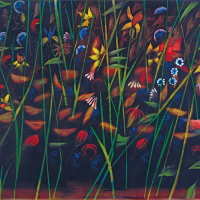56. CHARLES BLACKMAN

The grand scale of Blackmans paintings was precipitated by his studies of tapestries and work on tapestry cartoons. After being granted the Moya Dyring studio at the Cit Internationale des Arts in Paris in 1970 he travelled with his family, exploring Raphael in Rome, the Medici tapestries in Florence, the Venice Biennale, and Angers (for the modern Lurcat tapestries).
In Paris he worked on tapestries with frequent visits to the Cluny Museum (home of The Lady and the Unicorn), and to chateaux in the Loire Valley. He based his designs on gardens one on a balcony view of the knot garden in the courtyard of the Muse Carnavalet, Paris; one on the Jardin des Plantes, with a woman knitting where the greenhouse jungle recalls both Henri Rousseau and Queensland gardens; two on the Golders Hill Park in London where a peacock came to stare at him one London dawn; one on his paintings White Cats Garden at Evening and Children of the Night with children inhabiting shadows, not unlike the greenhouse garden.
As Nadine Amadio writes in her book, The Lost Domains, these tapestry-sized paintings are not just gardens:
They are flowers encircling a feeling or a secret atmosphere. In these quiet dramas with their luminosities of colour and their tender rhythms his gardens have the medieval power of illuminated stained glass windows with sunlight or even moonlight behind ... The Blackman Garden is very often frequented by a white cat which is a symbol of many things: innocence, childhood, a familiar night-self visiting secret places the enchanted gardens of memory.1
The floating hand in The Flower Garden is also reminiscent of earlier times, and especially of Blackmans lifelong attachment to the French Symbolist ancestor of surrealism Odilon Redon (1840-1916). Like Redon, Blackman shut himself up within nature. Blackmans discovery of the spiritual side of Redon was a photograph in a magazine of a bunch of flowers with the light shining through it, which Charles recognized as the chateau in which Redon had lived.
At the core of Blackmans art lies a duality like that of Redons art: a duality of dark and light, fantasy and fact; inside and outside, nightmare and dream; mysterious expression and pure plastic substance. This duality is internal as well as thematic. Within each picture the space itself is non-specific and yet palpably real, whereas the imagery is enigmatic and multi-layered. Even in the most lyrical of the Cats Garden and Rainforest paintings of the 70s and 80s, the brilliant colours are intensified and intersected with crevices of black. The dancing figure in the lower right is about something else: the soul.
Above all, Blackman was struck by the parallel between the fabulous Alice and the familiar, his wife Barbara; including her increasing sense of spatial disorientation to which they were both adjusting. The spaces in the painting have one foot in reality, almost literally. Because of her poor vision (Barbara was on a blind pension when they married), Blackman used to read aloud and the savouring of the words and slowing down of the pace allowed images to hang in the air. If you read out a book of poems you have to read them out slowly and gently and with a certain amount of precision, he told Robert Peach, an ABC interviewer in a joint interview with Barbara.2 This precision appears again in The Flower Garden as in the glimpsed presence of a recumbent Alice seen through the leaves.
Footnotes:
1. Amadio, N., Charles Blackman: The Lost Domains, A.H. & A.W. Reed, Sydney, 1980, p.80
2. Charles Blackman, in an interview with Robert Peach, Sunday Night Radio Two, ABC Radio, 9 September 1973, quoted in St. John Moore, F., Charles Blackman: Alice in Wonderland, National Gallery of Victoria, Melbourne, 2005, p.10
Felicity St John Moore
Felicity St John Moore is an art historian. She was formerly a curator at the National Gallery of Australia, Canberra, for seven years before becoming Guest Curator of Special Exhibitions at the National Gallery of Victoria, Melbourne. Her publications include Vassilieff and his Art (1982), Classical Modernism: The George Bell Circle (1992), Charles Blackman: Schoolgirls and Angels (1993) and Sam Fulbrook: Racing Colours (1995).